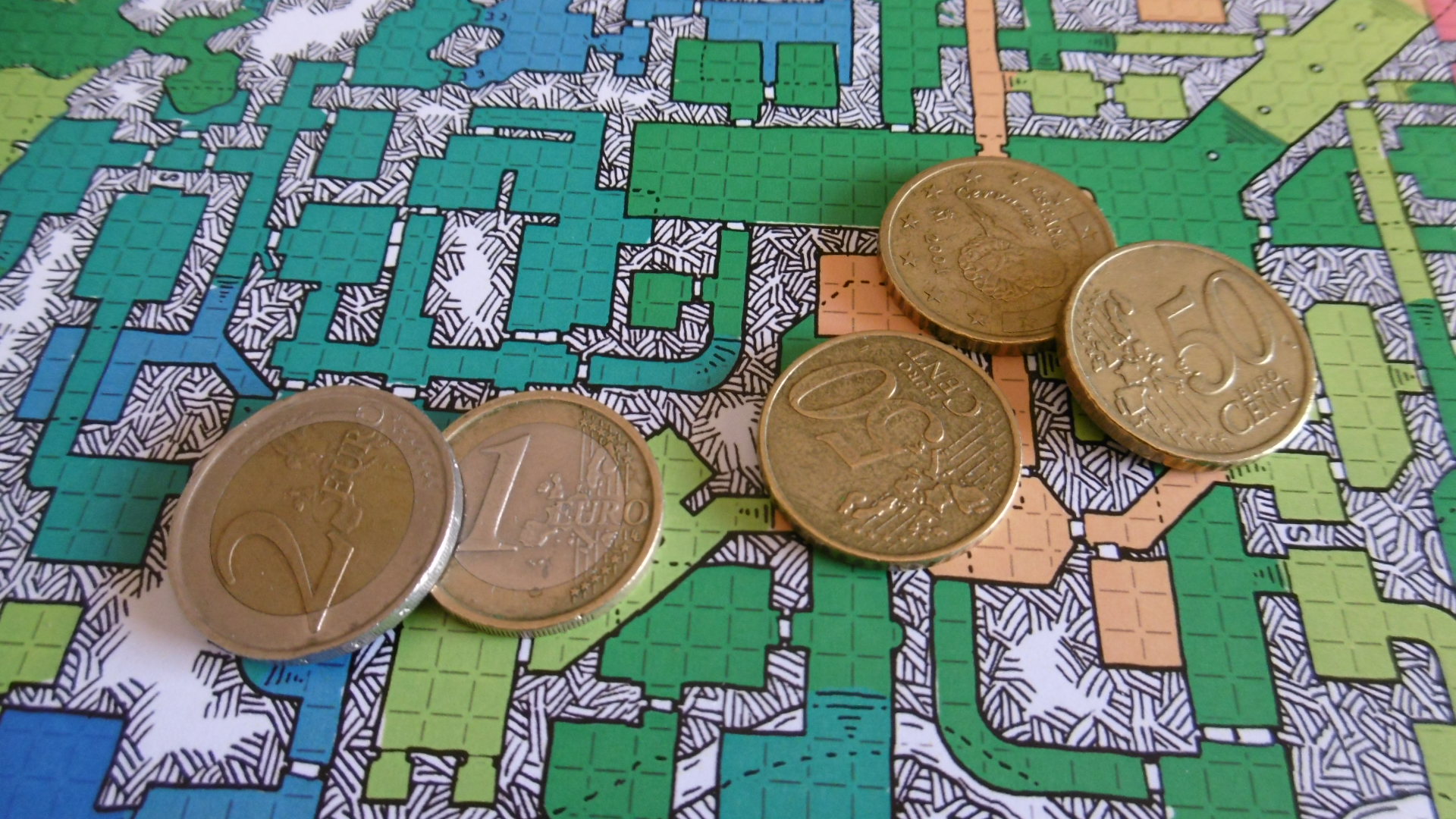In “Holmes on a Coin’s Weight,” we take the Editor’s proposed weight of a standard coin—twice that of a quarter—and calculate that 40 coins make a pound. This was prompted by questioning the validity of old-school D&D’s standard, ten coins to a pound, to measure encumbrance. Now I’m curious about the real weight of coins made from precious metals.
Source of Incongruence
In his review of the TREASURE chapter of the Holmes manuscript, Zach Howard notes that the section with heading BASE TREASURE VALUES (Holmes, 34), in which the weight of a coin is specified as twice that of a quarter, is not present.1 We deduce, then, that neither the 1⁄10 nor the 1⁄40 pound coin is proposed by Holmes. Rather, the incongruous weights entered the publication during editing.
I added a brief mention in an update to the earlier article.
Precious Metal Coin Weights
A US quarter-dollar piece, 1.75 mm thick and 24.26 mm in diameter, has a volume of 808.93 mm3 or 0.81 cm3. By the weight of the precious metals from which D&D realms mint coins, we can calculate the number of coins in a pound by metal. We ignore electrum as the alloy varies in weight depending on its composition.
| Precious Metal Pieces | |||||
|---|---|---|---|---|---|
| Piece | Copper | Silver | Gold | Platinum | Average |
| Volume (cm3) | 0.81 | 0.81 | 0.81 | 0.81 | 0.81 |
| 1 cm3 Weight (lbs.) | 0.0197 | 0.0231 | 0.0426 | 0.0473 | 0.0332 |
| Piece Weight (lbs.) | 0.0160 | 0.0187 | 0.0345 | 0.0383 | 0.0269 |
| Pieces in 1 lb. | 62.64 | 53.38 | 28.99 | 26.11 | 42.78 |
More precious metals are heavier. A pound of copper counts 64 pieces, while less than half that number make a pound of gold or platinum, 29 or 26 pieces respectively.
Forty Coins to a Pound
We could justify a pound of 40 coins by assuming most treasure hauls will have a mix of silver, gold, and platinum, with silver making up a half. We leave the copper pieces in a trail behind us, so we can find our way back to the hoard for a second load.2 The average of 53, 29, and 26 is 36 coins, which rounds up to an even 40.
And let’s take another look at the Holmes quarter-sized coin. Its weight, 0.025 pounds, is practically the average of the ensemble of precious metal coins: 0.027 pounds.
| Precious Metal Pieces Compared to the Holmes Quarter | ||
|---|---|---|
| Piece | Average of Precious Metal Pieces | Holmes Quarter |
| Volume (cm3) | 0.81 | 0.81 |
| 1 cm3 Weight (lbs.) | 0.0332 | 0.0309 |
| Piece Weight (lbs.) | 0.0269 | 0.0250 |
| Pieces in 1 lb. | 42.78 | 40.00 |
The average number of pieces per pound is 42.78. Adding electrum (not shown) with equal parts gold and silver brings the average down to 41.74.
Aside: Early Calculations
That the average weight of precious metal coins comes so close to Holmes’s twice-a-quarter’s-weight makes me wonder whether some editor might have done the research and made the calculations.
In the Internet Age, out of sheer curiosity, I looked up the precise dimensions of a quarter and plugged them into a volume calculator, found a web page that gives weights of metals by volume, and entered a few simple formulas into an electronic spreadsheet.
Certainly, the average 1970s high school student could accomplish the same,3 though by other means. All the calculations—the coin’s volume and each formula for each metal—must be done by hand, possibly with the assistance of a handheld calculator. Before doing the numbers, the research to find the weights of precious metals—unless one had a set of encyclopedias on the home shelf or a reference work noting specific gravities of metals—required a library trip.
Again, it was doable without the web, but it took more time and effort. Whoever did it, if it was done prior to 1977, had to be motivated.
Ten Coins to a Pound
To weigh one-tenth of a pound, how big would a coin have to be?
The average weight of 1 cm3 of the given precious metals is 0.033178 lbs. One-tenth pound divided by 0.033178 is 3.014. So we need about 3 cm3 of metal. A coin of that volume and, let’s say, twice a quarter’s thickness, 3.5 mm, must have a diameter of 33.1 mm, which is 1.30 inches or just shy of 15⁄16.
Coincidentally, the Eisenhower dollar coin, with a 1½-inch diameter and 1⁄10-inch thickness, has a volume of 2.8958 cm3. It weighs 24.624 grams or 1⁄20 of a pound. So, instead of a quarter dollar, we might say coins in D&D are the size of an Eisenhower dollar and twice the weight.
In a world of fantasy adventure, I could go with a coin of such an important size. It’s treasure, after all. It ought to look like treasure!
Still, even at quarter-size, we could argue for the ten-coin pound. As Moldvay suggests, when measuring encumbrance, we mustn’t neglect bulk. A coin seems to be the antithesis of bulk. It’s small, stackable with others, creates minimal lost space between pieces, and fistfuls of them fill voids between silver goblets and gold statuettes.
But a sack of coins isn’t rigid. I’m guessing that the only difference between a sack of 1,750 metal pieces and a party member’s corpse carried over your shoulder is that one of them will pay for a round at the base town tavern.

The 2- and 1-euro coins are just larger and just smaller than a quarter: 25.25 and 23.25 mm in diameter, respectively. The 50-cent piece is the closest match at 24.25 mm, though its thickness, 2.38 mm, is a third again that of a quarter.
Notes
1 Zenopus Archives blog, “Part 34: ‘Many Monsters Carry Treasure.’”
2 In adventurer jargon, copper pieces are called “dungeon marks.”
3 In a December 1983 Dragon article, David F. Godwin makes such calculations. “How many coins in a coffer?” (Dragon #80, 9) doesn’t question the tenth-pound coin but addresses the related problem of a coin hoard’s volume. One point Godwin makes is that, due to the heavier weights of metals, the volume of coins in a “full” sack is much less than the sack’s volume. Imagine a stack of ten quarters. It weighs one pound. Make six rows of stacks by ten columns. Rounding to convenient dimensions, a stack of ten quarters takes up a volume 1" × 1" × ¾". Stacked, the 600 coins take up 6" × 10" × ¾". Dump them into a large sack. Any more weight would burst the seams, but there’s still a lot of air in the volume. So much that even four times as many coins doesn’t begin to take up the space.
For an example of a large sack overfull, see the Erol Otus illustration in Moldvay’s D&D Basic Rulebook, B20.

It would, perhaps, make some sense to consider historical coinage from Medieval and Ancient times. The largest coin in the Greek world was the silver decadrachm, which weighed 43 grams, much larger than a silver thaler or the later dollar that was derived from it. Most coins were smaller, often much smaller. Size and weight depended on availability of the metal in question – during the earlier Middle Ages silver coins were small and thin, but in the Late Middle Ages and Renaissance, particularly after silver and gold were brought back from the Americas, coins get bigger.
Going back to the decadrachm, at 43 g it comes out to about 1/10.5 lbs, so very close to the ratio established by Holmes. Most coins though were smaller, so a 1/20 lb. coin or even smaller makes sense – really it’s dealers choice!
I would go with the bigger coins, though, since they present more of a logistics challenge to the players to recover, and also because they really do look like TREASURE! (I have some modern reproductions done in real silver of a number of ancient coins, and indeed some originals as well, and the big coins are amazing to hold in one’s hand!)
Thanks for all that information, Angantyr. I’m glad there’s some historical precedence for the 1/10th-lb coin. Makes me wonder how well versed Gygax and Arneson may have been in numismatics. In any case, we agree about the larger coins and about TREASURE in general.